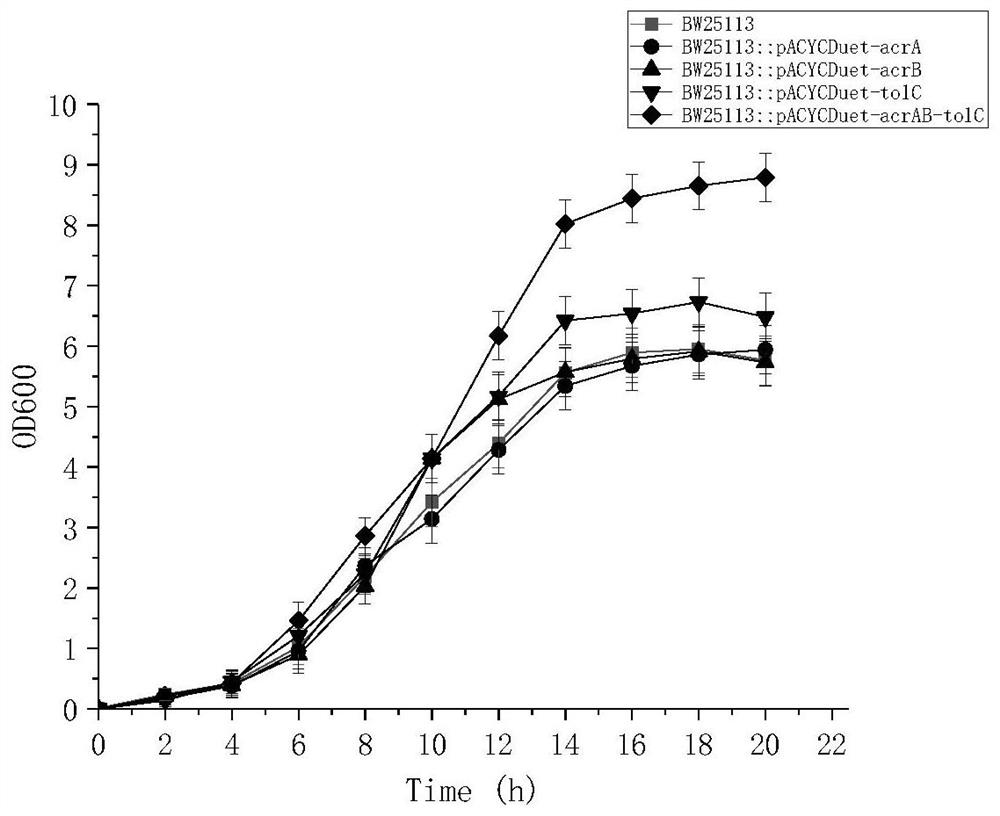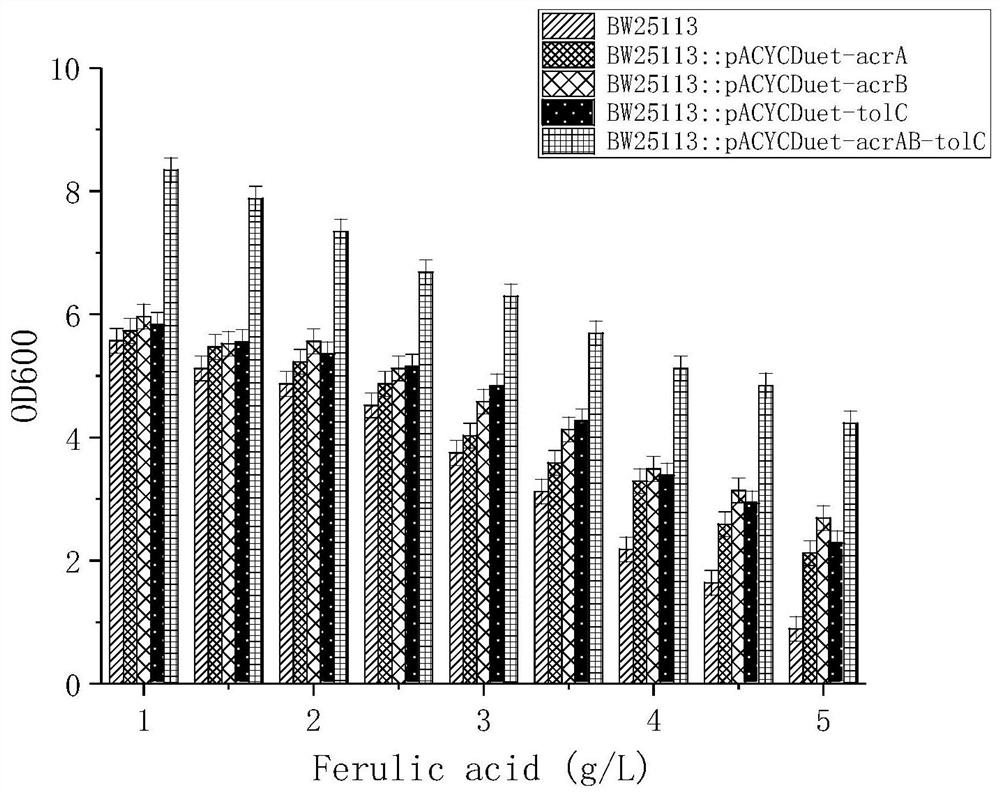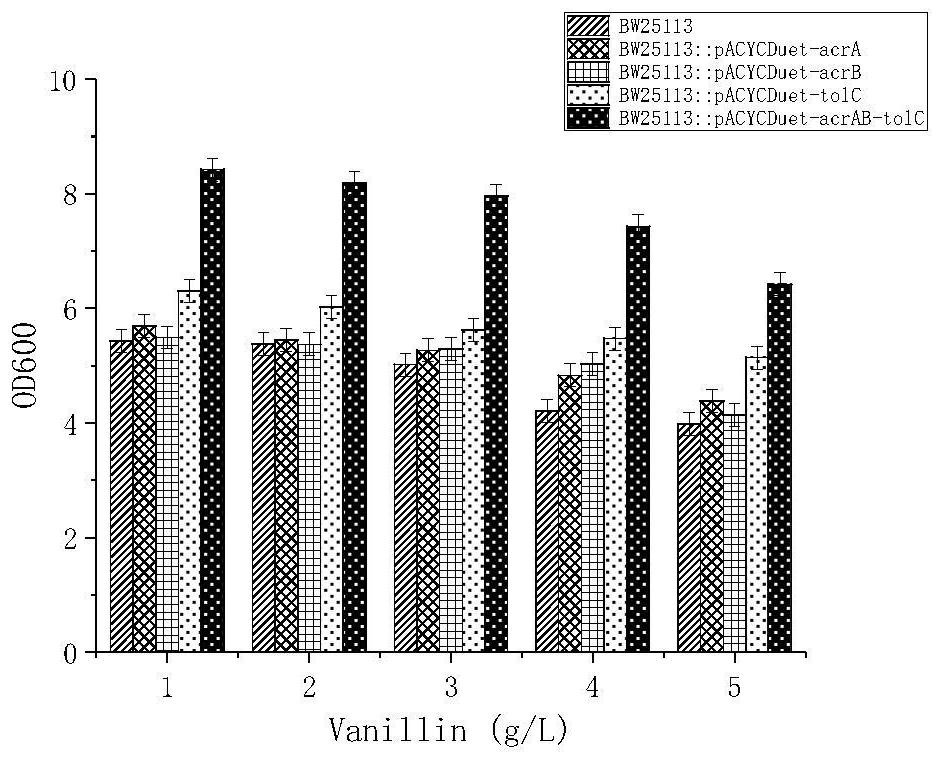A kind of recombinant gene engineering bacterium and its fermentative application to produce vanillin
A technology of genetically engineered bacteria and vanillin, applied in the direction of genetic engineering, fermentation, application, etc., to achieve good application prospects, enhance tolerance, and improve the effect of ability
- Summary
- Abstract
- Description
- Claims
- Application Information
AI Technical Summary
Problems solved by technology
Method used
Image
Examples
Embodiment 1
[0029] Example 1 Obtaining of the plasma membrane fusion protein AcrA amino acid sequence and nucleic acid sequence
[0030] The periplasmic membrane fusion protein gene sequence was screened using NCBI database, and a periplasmic membrane fusion protein gene was obtained. The sequence is derived from Escherichia coli (E.coli). According to the characteristics of the cloning vector pACYCDuet, the restriction endonucleases Nco I and Hind III restriction sites were designed. Using the genome of E. coli MG1655 strain as a template, primers acrA- u, acrA-d were amplified by PCR to obtain the periplasmic membrane fusion protein AcrA gene (shown in SEQ ID NO.1 (1-1394)), and the amino acid sequence of the encoded enzyme was shown in SEQ ID NO.2 (1-397) Show. The primer sequences are as follows:
[0031] acrA-u: 5′-taataaggagatataccatggGAATGTATGTACCATAGCACGACGA-3′;
[0032] acrA-d: 5'-gcattatgcggccgcaagcttCGCCAGCCCCCCTGCCAA-3'.
Embodiment 2
[0033] Embodiment 2 Construction of recombinant vector pACYCDuet-acrA and construction of engineering bacteria
[0034] The periplasmic membrane fusion protein AcrA gene fragment cloned in Example 1 was double-digested and recovered using restriction endonucleases Nco I and Hind III, and the fragment was treated with the same restriction endonuclease using T4 DNA ligase The treated cloning vector pACYCDuet was ligated at 22°C for 2 hours to construct the recombinant vector pACYCDuet-acrA.
[0035] The constructed recombinant vector pACYCDuet-acrA was transformed into recipient bacteria E.coli BW25113, spread on LB solid plates (containing 100 μg / mL ampicillin), and cultured at 37°C. Clones were randomly selected from the colonies grown on the plate, and the plasmids were extracted for agarose gel electrophoresis identification, and the engineering bacteria E.coli BW25113 / pACYCDuet-acrA were screened.
Embodiment 3
[0036] Example 3 Obtaining the Amino Acid Sequence and Nucleic Acid Sequence of Inner Membrane Transporter AcrB
[0037] The NCBI database was used to screen the gene sequence of the inner membrane transporter, and an inner membrane transporter gene was obtained. The sequence is derived from Escherichia coli (E.coli). According to the characteristics of the cloning vector pACYCDuet, the restriction endonucleases Nco I and Hind III restriction sites were designed. Using the genome of E. coli MG1655 strain as a template, primers acrB- u, acrB-d were amplified by PCR to obtain the inner membrane transporter AcrB gene (shown in SEQ ID NO.1 (1395-4744)), and the amino acid sequence of the encoded enzyme was shown in SEQ ID NO.2 (398-1446) . The primer sequences are as follows:
[0038] acrB-u: 5′-taataaggagatataccatggGTAAAAGCACAAGAAGTTACCGCTG-3′;
[0039] acrB-d: 5'-gcattatgcggccgcaagcttTTCGTATGAGATCCTGAGTTGGTG-3'.
PUM
 Login to View More
Login to View More Abstract
Description
Claims
Application Information
 Login to View More
Login to View More - R&D
- Intellectual Property
- Life Sciences
- Materials
- Tech Scout
- Unparalleled Data Quality
- Higher Quality Content
- 60% Fewer Hallucinations
Browse by: Latest US Patents, China's latest patents, Technical Efficacy Thesaurus, Application Domain, Technology Topic, Popular Technical Reports.
© 2025 PatSnap. All rights reserved.Legal|Privacy policy|Modern Slavery Act Transparency Statement|Sitemap|About US| Contact US: help@patsnap.com



